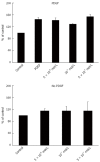Atorvastatin and rosuvastatin do not prevent thioacetamide induced liver cirrhosis in rats
- PMID: 23345947
- PMCID: PMC3547559
- DOI: 10.3748/wjg.v19.i2.241
Atorvastatin and rosuvastatin do not prevent thioacetamide induced liver cirrhosis in rats
Abstract
Aim: To examine whether the administration of atorvastatin and rosuvastatin would prevent experimentally-induced hepatic cirrhosis in rats.
Methods: Liver cirrhosis was induced by injections of thioacetamide (TAA). Rats were treated concurrently with TAA alone or TAA and either atorvastatin (1,10 and 20 mg/kg) or rosuvastatin (1, 2.5, 5, 10 and 20 mg/kg) given daily by nasogastric gavage.
Results: Liver fibrosis and hepatic hydroxyproline content, in the TAA-treated group was significantly higher than those of the controls [11.5 ± 3.2 vs 2.6 ± 0.6 mg/g protein (P = 0.02)]. There were no differences in serum aminotransferase levels in the TAA controls compared to all the groups treated concomitantly by statins. Both statins used in our study did not prevent liver fibrosis or reduce portal hypertension, and had no effect on hepatic oxidative stress. Accordingly, the hepatic level of malondialdehyde was not lower in those groups treated by TAA + statins compared to TAA only. In vitro studies, using the BrdU method have shown that atorvastatin had no effect of hepatic stellate cells proliferation. Nevertheless, statin treatment was not associated with worsening of liver damage, portal hypertension or survival rate.
Conclusion: Atorvastatin or rosuvastatin did not inhibit TAA-induced liver cirrhosis or oxidative stress in rats. Whether statins may have therapeutic applications in hepatic fibrosis due to other etiologies deserve further investigation.
Keywords: Liver cirrhosis; Statins; Thioacetamide.
Figures
Similar articles
-
NLRP3 inflammasome activation in coronary artery disease: results from prospective and randomized study of treatment with atorvastatin or rosuvastatin.Clin Sci (Lond). 2014 Feb;126(3):233-41. doi: 10.1042/CS20130043. Clin Sci (Lond). 2014. PMID: 23944632 Clinical Trial.
-
Effects of rosuvastatin and atorvastatin on the apolipoprotein B/apolipoprotein A-1 ratio in patients with an acute coronary syndrome: The CENTAURUS trial design.Arch Cardiovasc Dis. 2008 Jun;101(6):399-406. doi: 10.1016/j.acvd.2008.05.010. Epub 2008 Aug 20. Arch Cardiovasc Dis. 2008. PMID: 18809153 Clinical Trial.
-
Is rosuvastatin really a more efficient therapeutic option than atorvastatin?Value Health. 2006 Jul-Aug;9(4):276-7; author reply 277-9. doi: 10.1111/j.1524-4733.2006.00111.x. Value Health. 2006. PMID: 16903999 No abstract available.
-
Molecular mechanisms in thioacetamide-induced acute and chronic liver injury models.Environ Toxicol Pharmacol. 2023 Apr;99:104093. doi: 10.1016/j.etap.2023.104093. Epub 2023 Mar 2. Environ Toxicol Pharmacol. 2023. PMID: 36870405 Review.
-
Liver cirrhosis: An overview of experimental models in rodents.Life Sci. 2022 Jul 15;301:120615. doi: 10.1016/j.lfs.2022.120615. Epub 2022 May 5. Life Sci. 2022. PMID: 35526595 Review.
Cited by
-
Animal models of hepatotoxicity.Inflamm Res. 2016 Jan;65(1):13-24. doi: 10.1007/s00011-015-0883-0. Epub 2015 Oct 1. Inflamm Res. 2016. PMID: 26427493 Review.
-
Targeting HMGB1/TLR4 axis and miR-21 by rosuvastatin: role in alleviating cholestatic liver injury in a rat model of bile duct ligation.Naunyn Schmiedebergs Arch Pharmacol. 2019 Jan;392(1):37-43. doi: 10.1007/s00210-018-1560-y. Epub 2018 Sep 10. Naunyn Schmiedebergs Arch Pharmacol. 2019. PMID: 30203151
-
Atorvastatin and fluvastatin are associated with dose-dependent reductions in cirrhosis and hepatocellular carcinoma, among patients with hepatitis C virus: Results from ERCHIVES.Hepatology. 2016 Jul;64(1):47-57. doi: 10.1002/hep.28506. Epub 2016 Mar 25. Hepatology. 2016. PMID: 26891205 Free PMC article.
-
Lipid dysregulation in hepatitis C virus, and impact of statin therapy upon clinical outcomes.World J Gastroenterol. 2015 Jul 21;21(27):8293-303. doi: 10.3748/wjg.v21.i27.8293. World J Gastroenterol. 2015. PMID: 26217081 Free PMC article. Review.
-
Hepatoprotective and Anti-fibrotic Agents: It's Time to Take the Next Step.Front Pharmacol. 2016 Jan 7;6:303. doi: 10.3389/fphar.2015.00303. eCollection 2015. Front Pharmacol. 2016. PMID: 26779021 Free PMC article. Review.
References
-
- Tsukada S, Parsons CJ, Rippe RA. Mechanisms of liver fibrosis. Clin Chim Acta. 2006;364:33–60. - PubMed
-
- Bedossa P, Houglum K, Trautwein C, Holstege A, Chojkier M. Stimulation of collagen alpha 1(I) gene expression is associated with lipid peroxidation in hepatocellular injury: a link to tissue fibrosis? Hepatology. 1994;19:1262–1271. - PubMed
-
- Brenner DA, Chojkier M. Acetaldehyde increases collagen gene transcription in cultured human fibroblasts. J Biol Chem. 1987;262:17690–17695. - PubMed
-
- Houglum K, Bedossa P, Chojkier M. TGF-beta and collagen-alpha 1 (I) gene expression are increased in hepatic acinar zone 1 of rats with iron overload. Am J Physiol. 1994;267:G908–G913. - PubMed
MeSH terms
Substances
LinkOut - more resources
Full Text Sources
Other Literature Sources



